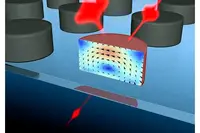 Researchers from Lomonosov Moscow State University and the Australian National University in Canberra have created an all optical switch on a silicon nanostructures and suggest the device may become a platform for future computers.
Researchers from Lomonosov Moscow State University and the Australian National University in Canberra have created an all optical switch on a silicon nanostructures and suggest the device may become a platform for future computers.
The work originated three years ago, when several groups of researchers determined that silicon nanoparticles exhibit strong resonances in the visible spectrum. This resonance is characterised by strong localisation of light waves on subwavelength scales, inside the nanoparticles. However, according to Maxim Shcherbakov, it was not thought that the discovery could create a basis for development of a compact and rapid photonic switch.
As part of the collaboration, nanoparticles were fabricated in the Australian National University by e-beam lithography followed by plasma phase etching. The samples were brought to Moscow, where the experimental work was carried out at the Faculty of Physics of Lomonosov Moscow State University.
The researchers developed a 250nm diameter disc that can switch optical pulses at femtosecond rates. This could, potentially, enable data to be transmitted at tens of Tbit/s.
The all-optical switch is based on the interaction between two femtosecond pulses created by the magnetic resonance of the silicon nanostructures. If the pulses arrive simultaneously, one interacts with the other and damps it. If there is a 100fs delay between the two pulses, the second pulse goes through the nanostructure without changing.
“We were able to develop a structure in which the undesirable free-carrier effects are suppressed,” said Shcherbakov. “Free carriers place serious restrictions on the speed of signal conversion in the traditional integrated photonics. Our work represents an important step towards novel and efficient active photonic devices.”
The team now plans to test the nanoparticles in integrated circuits.
Author
Graham Pitcher
Source: www.newelectronics.co.uk
